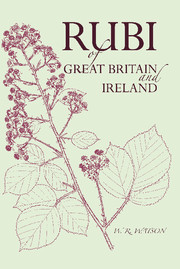Book contents
- Frontmatter
- Foreword
- Preface
- Contents
- INTRODUCTION
- I Environmental variations
- II Genetic intraspecific variations
- III Chromosomes and genes
- IV Reproduction
- V The species in Rubus
- VI Ecesis and migration
- VII Enemies, pests and diseases
- VIII Classification
- IX Collection and identification
- X Characteristics of the British-Irish bramble flora
- XI Cultivating native blackberries for fruit
- XII Note on the nomenclatural type species for the genus Rubus and subgenus Rubus
- XIII Key to the vice-county numbers
- XIV Signs and abbreviations
- ARRANGEMENT OF THE GENUS RUBUS LINN. IN AN ANALYTICAL KEY
- DESCRIPTIONS
- DRAWINGS
- Glossary
- Principal works consulted
- Index
- Frontmatter
- Foreword
- Preface
- Contents
- INTRODUCTION
- I Environmental variations
- II Genetic intraspecific variations
- III Chromosomes and genes
- IV Reproduction
- V The species in Rubus
- VI Ecesis and migration
- VII Enemies, pests and diseases
- VIII Classification
- IX Collection and identification
- X Characteristics of the British-Irish bramble flora
- XI Cultivating native blackberries for fruit
- XII Note on the nomenclatural type species for the genus Rubus and subgenus Rubus
- XIII Key to the vice-county numbers
- XIV Signs and abbreviations
- ARRANGEMENT OF THE GENUS RUBUS LINN. IN AN ANALYTICAL KEY
- DESCRIPTIONS
- DRAWINGS
- Glossary
- Principal works consulted
- Index
Summary
The conception that an apparently almost innumerable multiplicity of forms exists is felt by many naturalists of the old school to be intolerable. The fact may be denied in the study: in the open field it will have to be accepted by everyone who looks around. It is certainly downright disquieting that in many genera (Rubus, Rosa, Hieracium…) there is such an extraordinary number of species and forms that really nature seems for once not to be created for the convenience of the systematist
focke, Syn. Rub. Germ. (1877), 3THE classification adopted in this work for MORIFERI has a twofold basis. Focke and Gremli collaborated for many years to discover the most suitable characters on which to base their arrangement of the forms of western Europe. They finally settled upon the comparative development in size and distribution of prickles, pricklets, acicles and stalked glands. Although no better master-plan has been discovered, it assumes that one will possess full knowledge of the climax of development of these structures in all species, and will not be misled by their imperfect evolution in young and shade-grown plants. On this basis, then, Focke proposed fifteen groups (including TOMENTOSI, which is not represented in Britain), and proceeded to distribute his species amongst them. Recognizing that some of them, whilst belonging technically to one group, showed natural affinities to species which he had assigned to another group, he often decided to place them where their natural affinity lay. This practice he further developed in his second and third, and most of all in his final work, whilst retaining all the time with one exception the original names for his groups. The result is that a beginner who wishes to identify an unknown bramble is at a loss to know where to look for it, although Focke has sometimes mentioned a species under two groups; but anyone who knows the name of the bramble in which he is interested, and simply wishes to see Focke's account of it and his views of its relationship to other species, will have no difficulty in finding what he wants through the index.
The classification adopted in this work is based in its main outlines upon the nature of the armature, and coincides more or less with Focke's main divisions.
- Type
- Chapter
- Information
- Handbook of the Rubi of Great Britain and Ireland , pp. 17 - 18Publisher: Cambridge University PressPrint publication year: 2013



